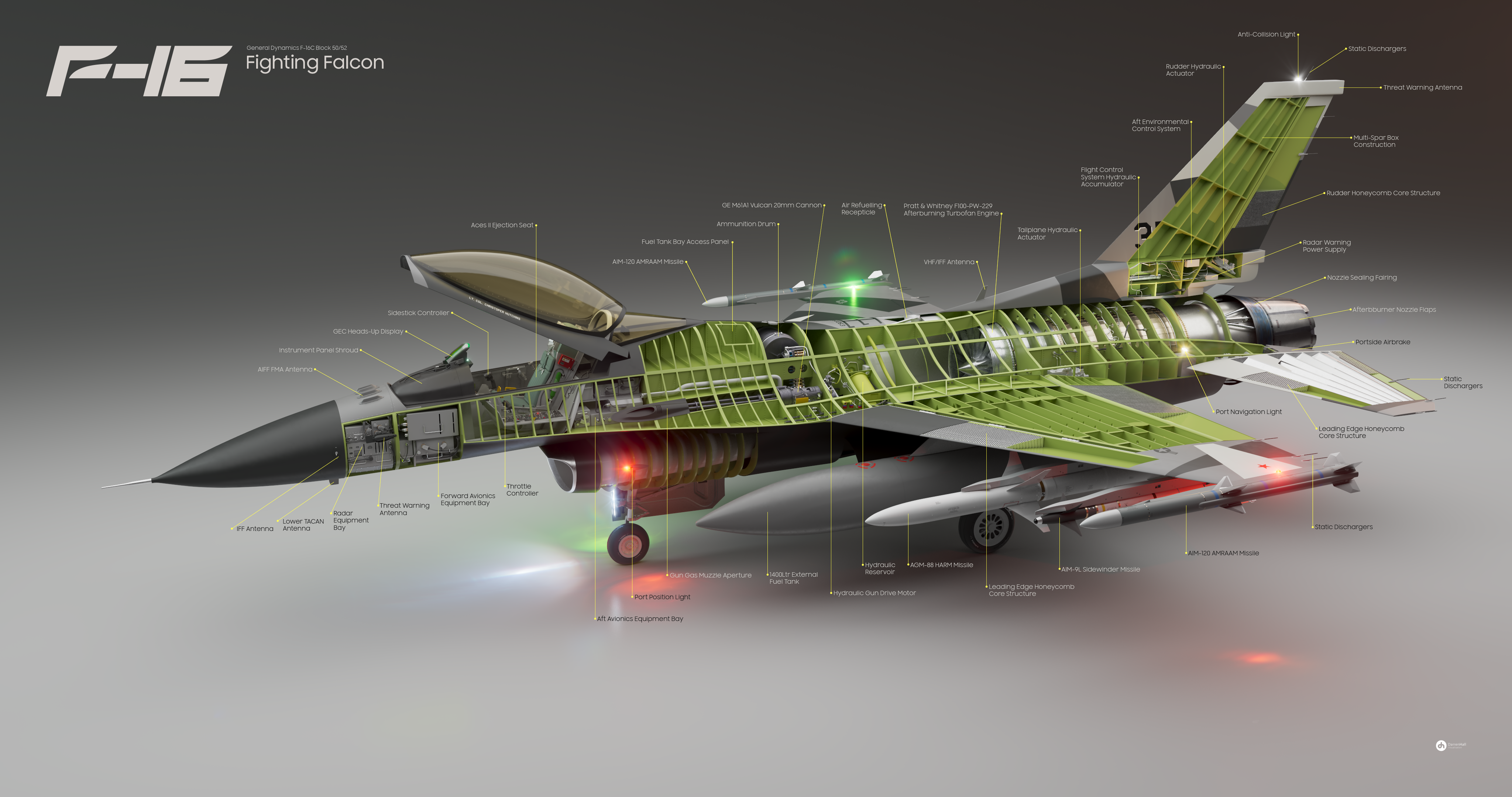The F-16 Fighting Falcon is one of the most advanced and versatile fighter jets in the world. It can perform a variety of missions, from air-to-air combat to ground attack and reconnaissance. But what makes this aircraft so powerful and agile? How does it withstand the extreme forces and temperatures of high-speed flight? I will take you on a tour of the F-16’s internal structure, using a 3D rendered cutaway image that reveals its key components and systems. You will see how the F-16 is designed to optimize performance, safety, and reliability in any situation.
F-16 Under the Skin Cutaway
The F-16 Fighting Falcon is one of the most versatile and agile fighter jets in the world. It can perform a variety of missions, from air-to-air combat to ground attack to reconnaissance. But what makes this aircraft so powerful and reliable? How does it work? What are its main components and systems? In this page, we will give you an inside look at the F-16 Fighting Falcon with this stunning and informative 3D rendered cutaway image that shows you the internal structure of the jet. You will learn about the engine, the cockpit, the weapons, the avionics, and more. Let’s dive in!
The Engine
The heart of the F-16 is the General Electric F110-GE-129 turbofan engine, which provides up to 29,000 pounds of thrust. The engine is located in the rear fuselage, behind the cockpit, and has a single inlet on the bottom of the aircraft. The engine has two spools, a low-pressure compressor and a high-pressure compressor, that compress the air before it enters the combustion chamber, where it is mixed with fuel and ignited. The hot gases then expand through a high-pressure turbine and a low-pressure turbine, which drive the compressors. The exhaust gases exit through a nozzle that can be adjusted to optimize thrust and manoeuvrability.
The Cockpit
The cockpit of the F-16 is designed to give the pilot maximum visibility and comfort. The pilot sits in a reclined position, at an angle of 30 degrees, to reduce the effects of high g-forces. The cockpit has a large bubble canopy that offers a 360-degree view of the surroundings. The cockpit also features a head-up display (HUD), which projects vital information such as speed, altitude, attitude, and weapon status on a transparent screen in front of the pilot’s eyes. The pilot can also use a helmet-mounted display (HMD), which shows similar information on a visor attached to the helmet. The pilot controls the aircraft with a side-stick controller on the right side and a throttle on the left side. The cockpit also has various switches, buttons, and displays that allow the pilot to monitor and operate the systems of the aircraft.
The Weapons
The F-16 can carry a wide range of weapons for different missions. The aircraft has nine hardpoints, or attachment points, for external weapons: one under the fuselage, six under the wings, and two on the wingtips. The F-16 can carry air-to-air missiles such as AIM-9 Sidewinder, AIM-120 AMRAAM, and IRIS-T; air-to-ground missiles such as AGM-65 Maverick, AGM-88 HARM, and AGM-158 JASSM; bombs such as GBU-10 Paveway II, GBU-31 JDAM, and GBU-39 SDB; rockets such as Hydra 70; and pods such as AN/ALQ-131 ECM pod, AN/AAQ-28 Litening targeting pod, and Sniper XR advanced targeting pod. The F-16 also has an internal 20 mm M61 Vulcan cannon with 511 rounds of ammunition.
The Avionics
The avionics are the electronic systems that help the pilot fly and fight with the F-16. The avionics include a radar, a flight control system, a navigation system, a communication system, a data link system, an identification system, a countermeasure system, and a diagnostic system. The radar is an AN/APG-68(V)9 multimode radar that can detect and track targets in both air-to-air and air-to-ground modes. The radar can also provide terrain-following and terrain-avoidance functions for low-level flight. The flight control system is a fly-by-wire system that uses electrical signals to control the movement of the aircraft’s surfaces.
F-16 Flight Controls
The flight control system also has a digital flight control computer that enhances the stability and manoeuvrability of the aircraft. The navigation system is based on an inertial navigation system (INS) that uses gyroscopes and accelerometers to measure the position and velocity of the aircraft. The navigation system also uses GPS satellites to improve accuracy. The communication system consists of two radios that allow the pilot to communicate with other aircraft and ground stations.
Data Links
The data link system is an AN/ASQ-213 HTS pod that allows the pilot to exchange information with other friendly forces via Link 16 network. The identification system is an AN/APX-113 AIFF system that helps the pilot identify friend or foe (IFF) targets. The countermeasure system is an AN/ALR-69 radar warning receiver (RWR) that alerts the pilot of incoming radar signals from enemy sources. The countermeasure system also includes chaff and flare dispensers that can be used to decoy incoming missiles. The diagnostic system is an AN/AYK-14 central computer that monitors and tests the health of various subsystems of the aircraft.
We hope you enjoyed this inside look at the F-16 Fighting Falcon with this 3D cutaway image. If you want to learn more about this amazing fighter jet, you can visit the official website of the U.S. Air Force or the Lockheed Martin Corporation, the manufacturer of the F-16.
Website:
F-16 Fighting Falcon | Lockheed Martin


